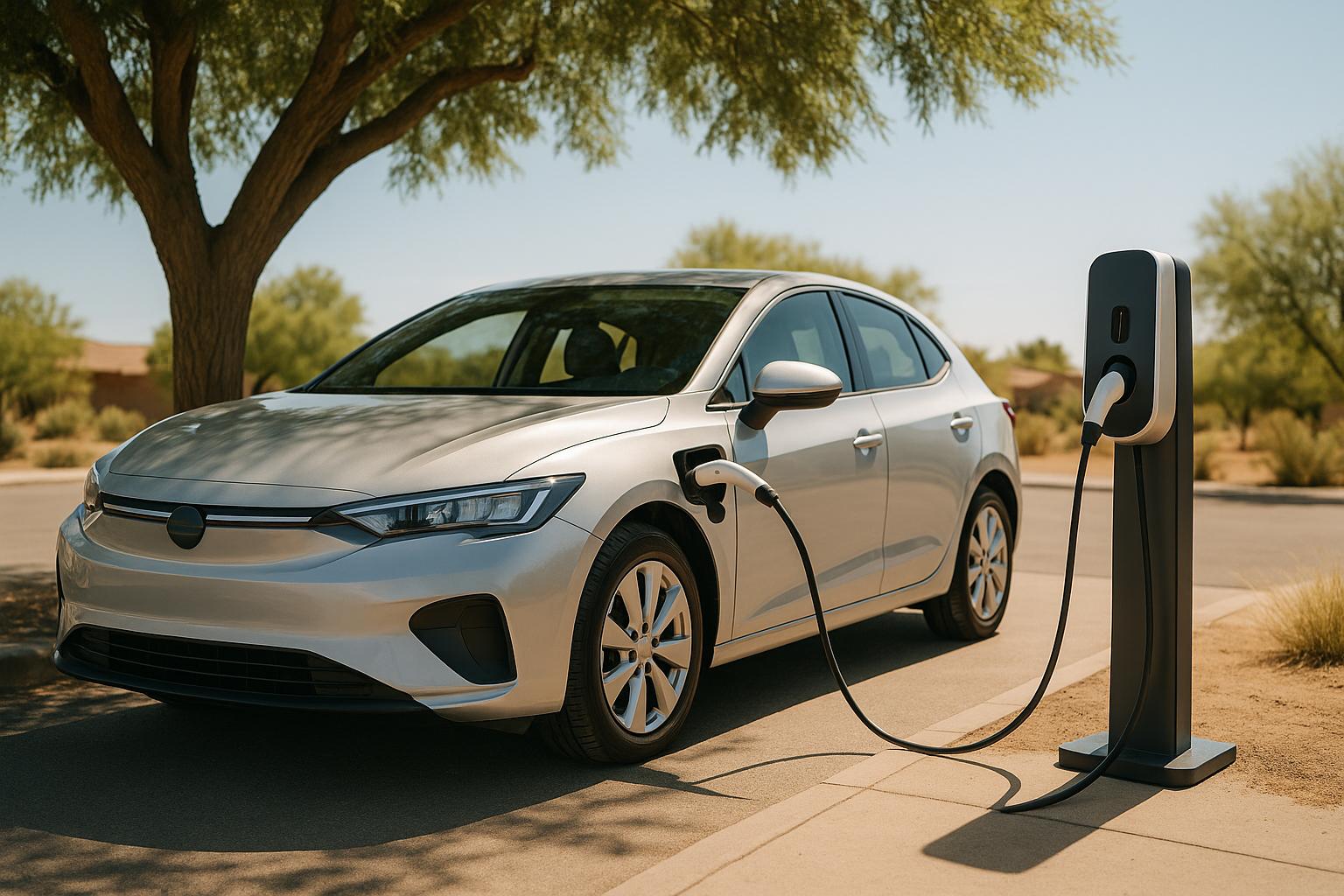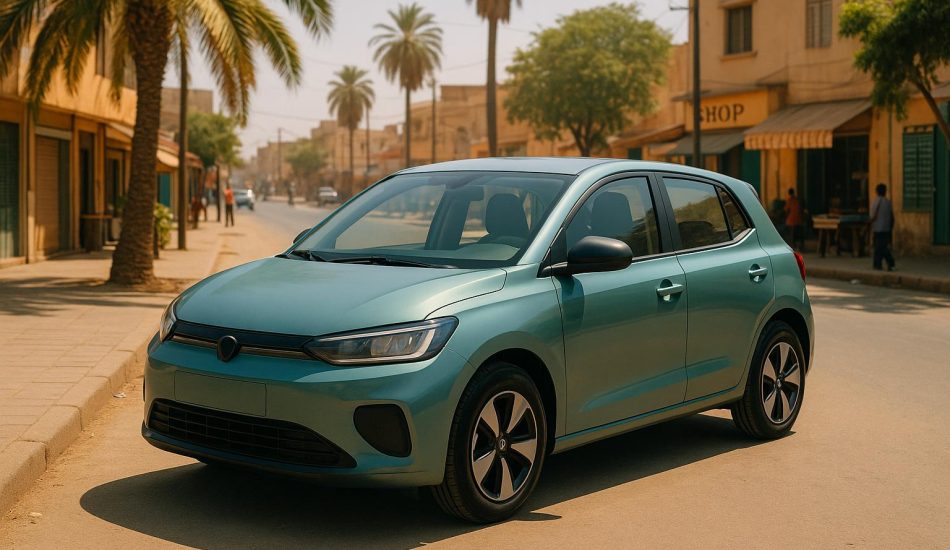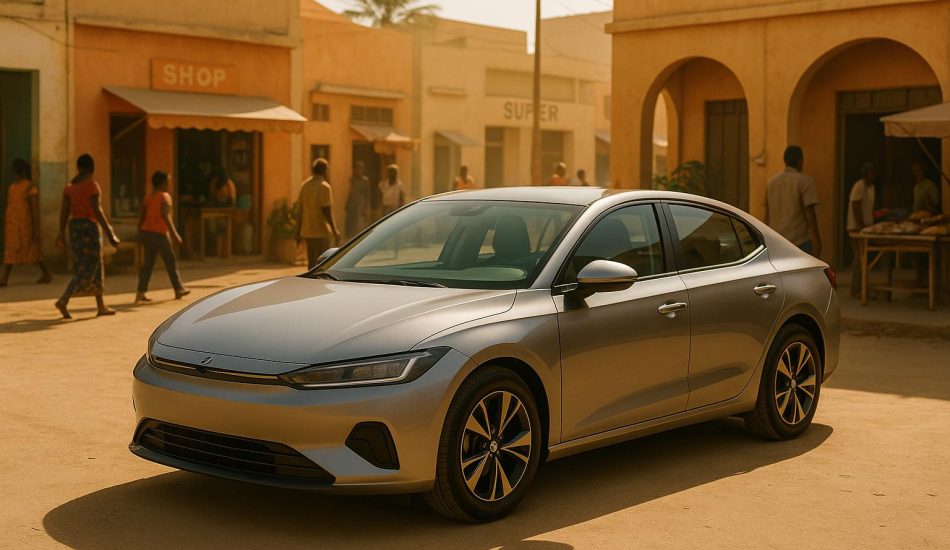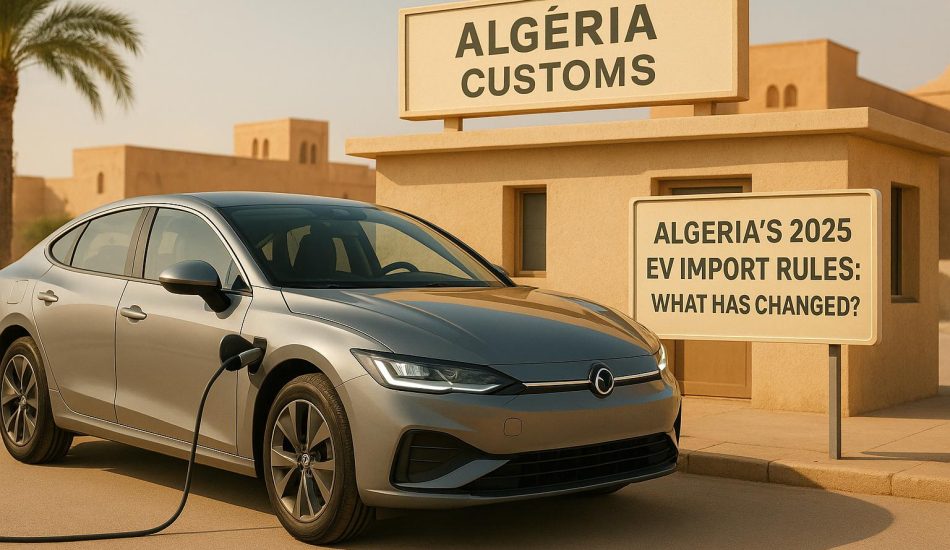
When temperatures hit triple digits, your EV’s battery can take a hit. Extreme heat speeds up wear and tear, reduces charging efficiency, and can even shorten the battery’s lifespan. While EVs come with built-in cooling systems, they’re not always enough. Here’s how you can protect your battery and keep your EV running efficiently during hot weather:
- Park Smart: Use shaded or covered parking. If unavailable, use reflective sunshades or UV-resistant car covers.
- Charge Wisely: Keep your battery between 30%-80%, charge during cooler hours, and limit fast charging.
- Check Cooling Systems: Regularly inspect your EV’s cooling system and watch for overheating signs like dashboard warnings or reduced range.
- Store Properly: For extended storage, keep the battery charge between 30%-50% and monitor it periodically.
- Stay Proactive: Schedule professional checkups, especially before summer, to catch issues early.
These simple steps can help extend your EV battery’s life and performance, even in high temperatures.
Best Tips to Maximize EV Battery Life In Hot Weather. How Hot Weather Affects Your EV Range.
Park and Store in Cool Areas
Keeping your EV in a cool, shaded spot can go a long way in protecting its battery. Heat is one of the biggest culprits behind battery degradation, as it puts extra strain on the cooling system. Parking in direct sunlight raises the interior temperature, which can speed up wear and tear on your battery. A little shade can make a big difference in preserving its lifespan. Let’s look at how covered parking can be a game-changer.
Use Covered Parking Spaces
Garages, carports, and parking structures are excellent options for shielding your EV from excessive heat. Underground parking is particularly effective since it stays naturally cooler throughout the day. These spaces not only protect your car from direct sunlight but also help keep the interior temperature under control.
When charging at public stations, try to find covered or underground options. At your workplace or during errands, opt for shaded parking even if it means walking a bit further.
"Whenever possible, park in the shade to keep your vehicle cooler and reduce the demand on the climate control system when you park your car." – Charlotte Argue, Senior Manager, Sustainable Mobility at Geotab
Use Sunshades and Car Covers
If covered parking isn’t available, don’t worry – there are other ways to combat the heat. Reflective sunshades can lower the interior temperature by 15–25°F (8–14°C) on hot days. Windshield sunshades are particularly effective since they block the largest glass surface, while side window shades add extra protection for passengers and electronics.
For extended parking periods, a breathable car cover designed for hot climates can help. Look for light-colored, UV-resistant covers that reflect sunlight and allow air to circulate, preventing heat and moisture buildup. Just make sure the shade remains consistent throughout the day for maximum effect.
"When parking your EV, pick a shaded spot to keep your EV and battery cooler without using pre-conditioning. It’s a free way to manage hot weather!" – The Electric Car Scheme
Adjust Charging Habits for Hot Weather
Hot weather can be tough on your EV’s battery, but tweaking your charging habits can help manage the heat and keep your battery in good shape. The goal is to understand how high temperatures impact the charging process and make adjustments that protect your battery’s performance. Here’s how you can adapt your routine to handle the heat.
Keep Charge Between 30% and 80%
In hot climates, keeping your battery charge between 30% and 80% is especially important. This range helps stabilize the battery and reduces the extra strain caused by high temperatures. Charging all the way to 100% in hot weather can generate excess heat inside the battery, speeding up chemical reactions that lead to faster wear and tear. On the flip side, letting the charge dip below 30% can also stress the battery. Sticking to this middle range helps slow down degradation and extend the battery’s lifespan.
Charge During Cooler Hours
Charging when it’s cooler outside can make a noticeable difference. Early mornings (around 5:00 AM to 8:00 AM) or evenings after 7:00 PM tend to have lower temperatures, making them ideal for charging. Many EVs let you schedule charging, so you can set it to start during these cooler periods. While you’re at it, consider pre-cooling your car’s cabin using grid-powered air conditioning while it’s plugged in. This not only keeps the interior comfortable but also helps optimize the battery’s temperature.
Limit Fast Charging
Fast charging might be convenient, but it’s not your battery’s best friend in hot weather. It generates more internal heat, which can lead to thermal stress and chemical instability. Frequent fast charging under these conditions can reduce the battery’s capacity, slow down future charging speeds, and shorten its overall lifespan. In extreme cases, your EV’s battery management system (BMS) might even slow down or temporarily stop charging until the battery cools down.
"Heat is one of the most silent threats to EV battery health. The good news is, with a little knowledge and the right tools, drivers can minimize the damage and keep their vehicles running efficiently for years." – Nick Zamanov, EV infrastructure expert, CyberSwitching
sbb-itb-99e19e3
Check Battery Cooling Systems
Your EV’s cooling system plays a key role in keeping the battery at the right temperature, especially in warmer climates where overheating can be a real concern. Think of it as the battery’s personal air conditioner, working to maintain temperatures between 68°F and 95°F while minimizing internal differences to less than 9°F. This careful balance helps reduce uneven wear and extends battery life.
Get Regular System Checkups
If you live in a hot region, scheduling regular professional inspections is a must. For instance, the Stone Mountain Volkswagen Service Center in Atlanta, GA, advises electric VW owners to get their cooling systems checked before the summer heat kicks in. In July 2025, they highlighted the importance of having certified technicians assess high-voltage components for heat stress, test the cooling system under load, and ensure software systems are properly tuned for summer driving. With Atlanta temperatures often hitting 95°F, this kind of proactive maintenance can make a big difference in keeping your battery healthy.
Between professional checkups, you can perform some basic maintenance yourself. Start by locating the battery coolant reservoir – usually found in the front trunk or under the hood. When the system is cool, check that the fluid level is between the “MIN” and “MAX” marks. The coolant should be clear, free of particles, and match the color specified by your manufacturer, typically orange, pink, or blue. Don’t forget to inspect for leaks or damage in the surrounding components and connections. Always wait at least 30 minutes after driving before checking the system, and refer to your owner’s manual for exact details on locations and procedures.
Watch for Overheating Warning Signs
Routine inspections can help you address cooling system issues before they escalate. However, your EV is designed to alert you if the system struggles. Dashboard warnings about battery temperature are the most obvious signs, but other clues can appear earlier. For example, if your driving range drops suddenly without explanation or fast charging takes noticeably longer, your cooling system might need attention.
Stay tuned to your car’s daily performance. A sudden, unexpected loss of battery capacity could point to temperature regulation problems. Error codes tied to the thermal management system also indicate it’s time for a professional checkup. Visible coolant leaks are another red flag, as are cooling fans that run continuously even when the car is parked. If your air conditioning seems less effective, that’s another hint that the cooling system might be struggling.
The Battery Management System (BMS) plays a critical role here, constantly monitoring battery temperature and controlling components like the coolant pump and cooler. If the BMS detects an issue, it may limit your EV’s performance to protect the battery. So, any noticeable changes in how your car drives or charges deserve immediate attention.
Store Your EV Properly in Hot Weather
Prolonged exposure to high temperatures can speed up lithium-ion battery wear. To keep your EV’s battery in good shape, it’s crucial to store it under the right conditions. These tips build on earlier advice about charging and parking, focusing specifically on periods of extended inactivity.
Keep the Battery at a Moderate Charge Level
When storing your EV in hot weather for an extended time, aim to keep the battery charge between 30% and 50%. This range helps reduce stress on the battery, preventing wear caused by operating at very high or very low charge levels. Many modern EVs come with built-in battery management tools to help maintain this balance. Check your owner’s manual for specific recommendations from your vehicle’s manufacturer. If your EV doesn’t have automated management features, make it a habit to check the charge level occasionally and adjust if needed.
Steer Clear of Extreme Charge Levels
While maintaining a moderate charge is essential, it’s equally important to avoid storing your EV with the battery fully charged or nearly empty. Both extremes can put unnecessary strain on the battery and may affect its ability to recharge efficiently later on.
Check the Battery Periodically
Even when your EV is parked for a long time, don’t forget about the battery. Heat can cause batteries to lose charge more quickly, so it’s a good idea to monitor the battery status every so often. Many EVs have mobile apps that let you check the charge remotely, saving you a trip to the car. If you notice the battery draining faster than expected or receive warning alerts, it’s wise to consult a professional to ensure everything is functioning properly.
Conclusion: Get Expert Support for Your EV
Taking care of your EV battery, especially in hot weather, is crucial to ensuring its longevity and performance. As we’ve discussed, managing heat-related challenges through smart battery care not only protects your vehicle but also safeguards your investment.
By sticking to these five key tips, you can help your battery last longer and keep your EV running smoothly, even in the most demanding climates. Hot weather can be tough on electric vehicles, but with consistent attention and maintenance, your EV can deliver reliable performance for years.
If you’re in the market for an electric vehicle or need advice on choosing one suited to hot climates, EV24.africa is a great place to start. As Africa’s first online marketplace dedicated to electric cars, they make the buying process straightforward and offer expert advice. Their curated selection includes trusted brands like Tesla and BYD, which are well-suited for Africa’s challenging temperatures.
Whether you’re purchasing your first EV or upgrading to a newer model, having expert guidance can make all the difference. With the right support and proactive care, your EV can thrive in hot climates while requiring minimal battery maintenance. Stay ahead, and keep your EV efficient and dependable in Africa’s unique conditions.
FAQs
How does hot weather impact the performance and lifespan of an EV battery?
Prolonged exposure to high temperatures can take a toll on the performance and longevity of an electric vehicle (EV) battery. Once temperatures climb above 85°F, the battery’s internal resistance starts to rise, speeding up chemical wear and tear. Over time, this can lower the battery’s capacity and shorten its usable life.
Thankfully, modern EVs come with thermal management systems designed to keep battery temperatures in check and reduce heat-related damage. But if you live in a hot climate, a little extra care goes a long way. Simple steps like parking in the shade and avoiding overcharging can help keep your battery in good shape and performing at its best.
How can I safely charge my EV battery in hot climates to avoid overheating?
In hot climates, protecting your EV battery requires a bit of extra care. One key tip is to avoid using fast chargers during extreme heat, as they can add extra thermal stress to the battery. Instead, aim to keep your battery charge level between 20% and 80% – this range helps maintain its performance and extend its lifespan.
Another helpful step is parking your EV in shaded or cooler spots whenever possible, especially before charging. You can also precondition the cabin to help stabilize the battery’s temperature. These small adjustments can make a big difference in preventing overheating and keeping your EV battery in good shape for the long haul.
Why is it important to check your EV’s cooling system regularly, and what are the warning signs it needs servicing?
Keeping an eye on your EV’s cooling system is crucial for safeguarding the battery against overheating. Overheating can lead to a shorter battery lifespan, reduced performance, or even potential safety hazards. This becomes even more important in hot climates, where high temperatures can put additional stress on the cooling system.
Be alert to warning signs such as coolant leaks, low coolant levels, debris clogging the radiator, or unexpected temperature spikes on your dashboard. Tackling these issues promptly ensures your EV operates smoothly and helps maintain the battery’s condition over the long haul.




